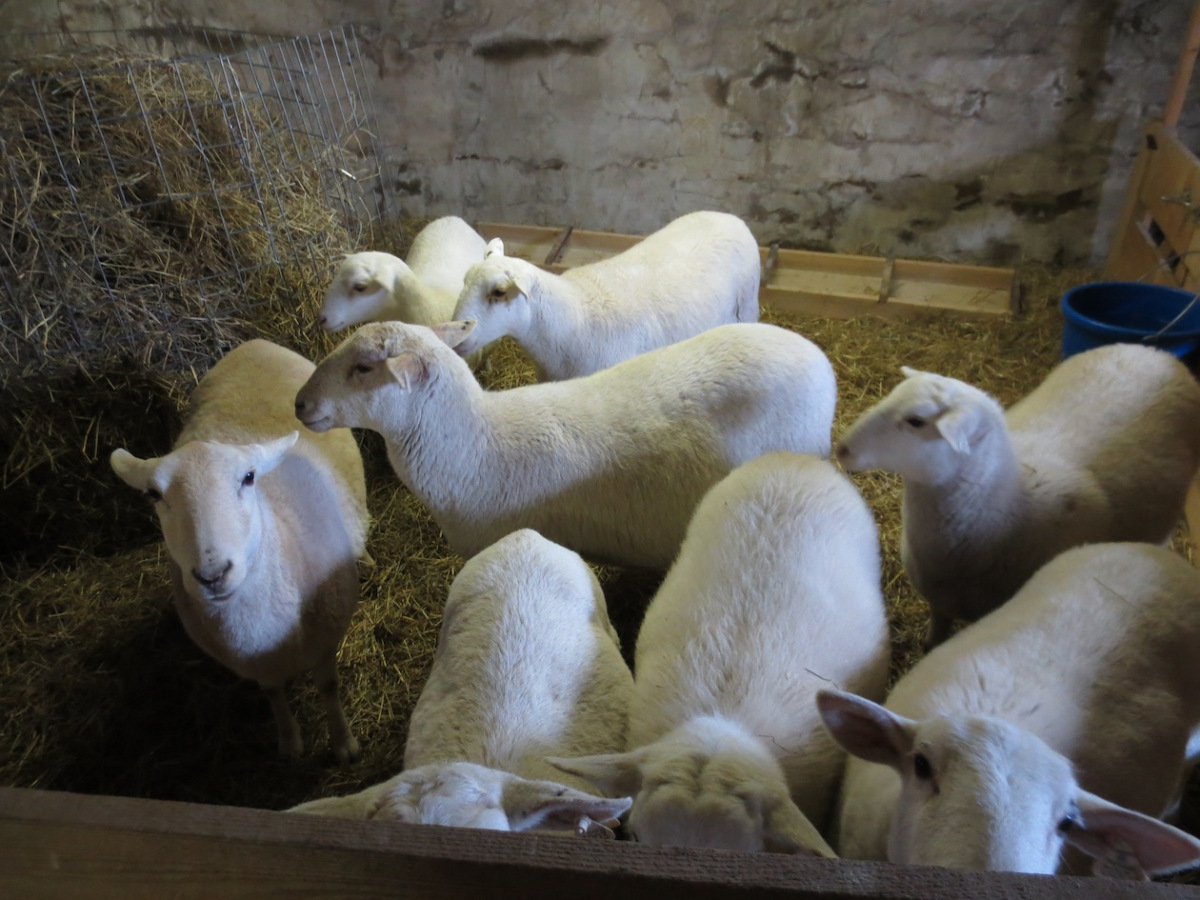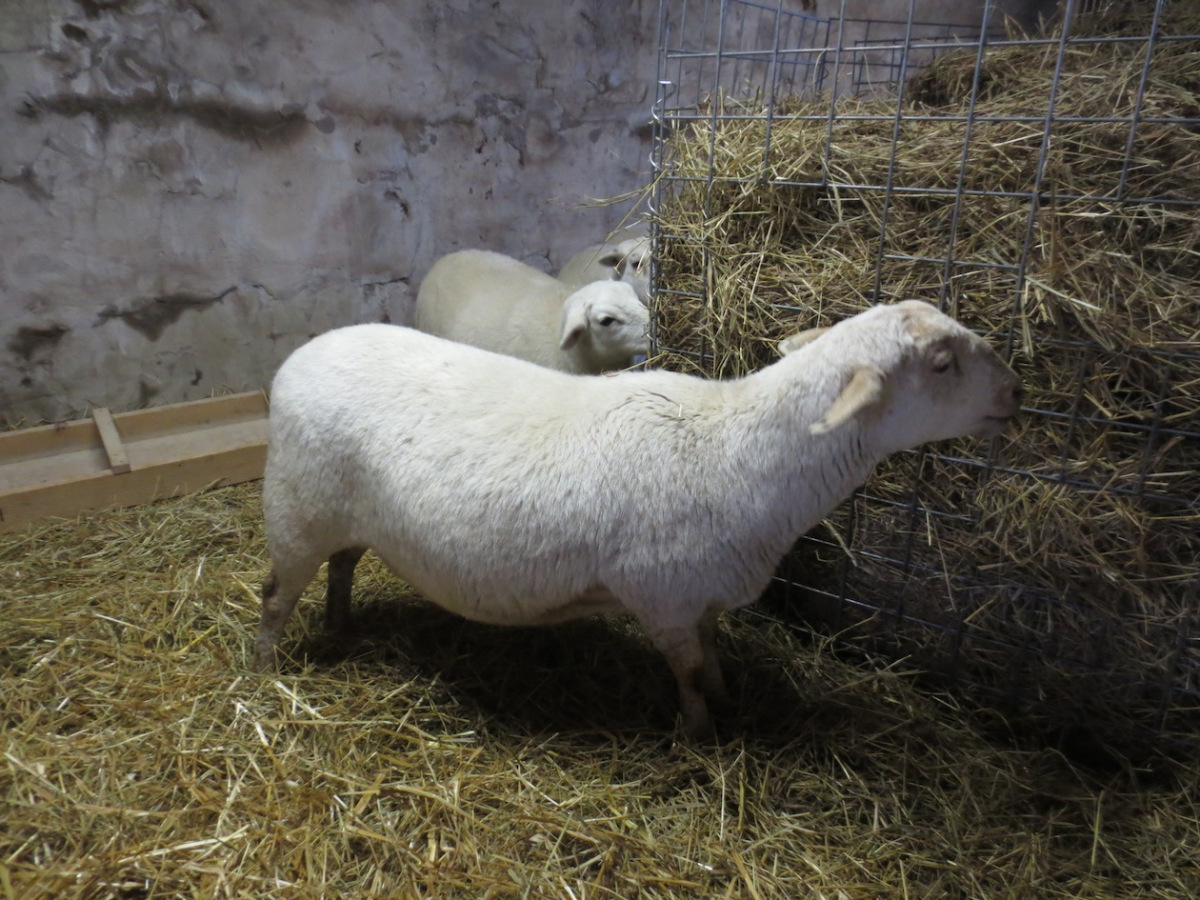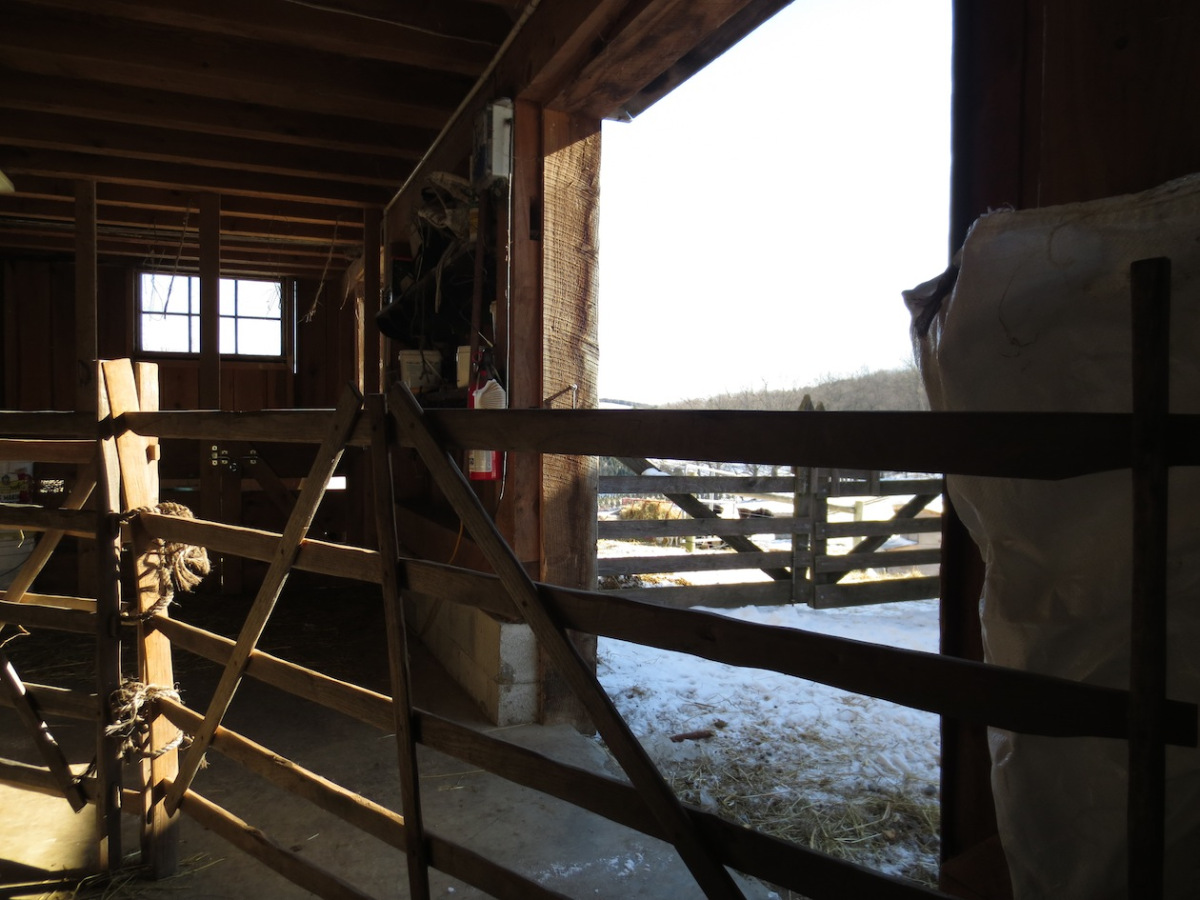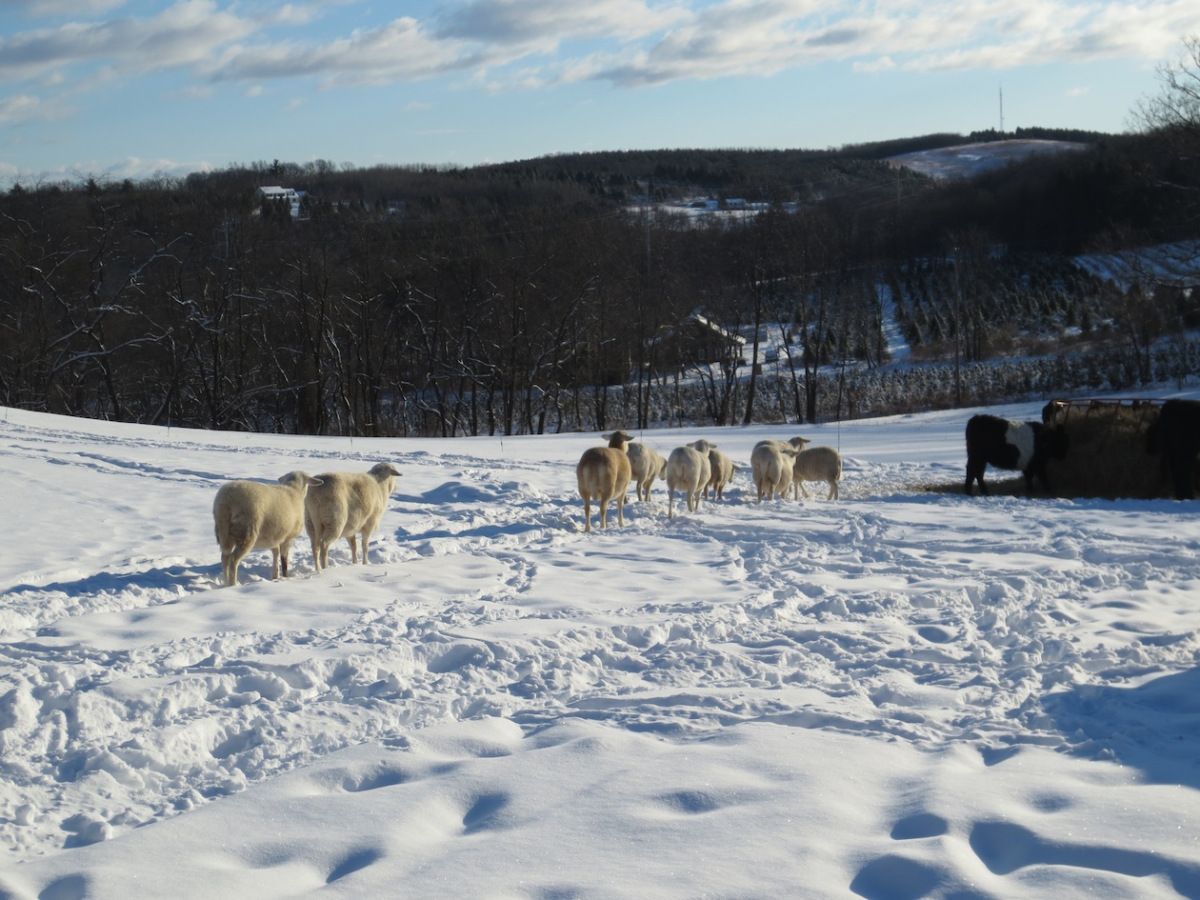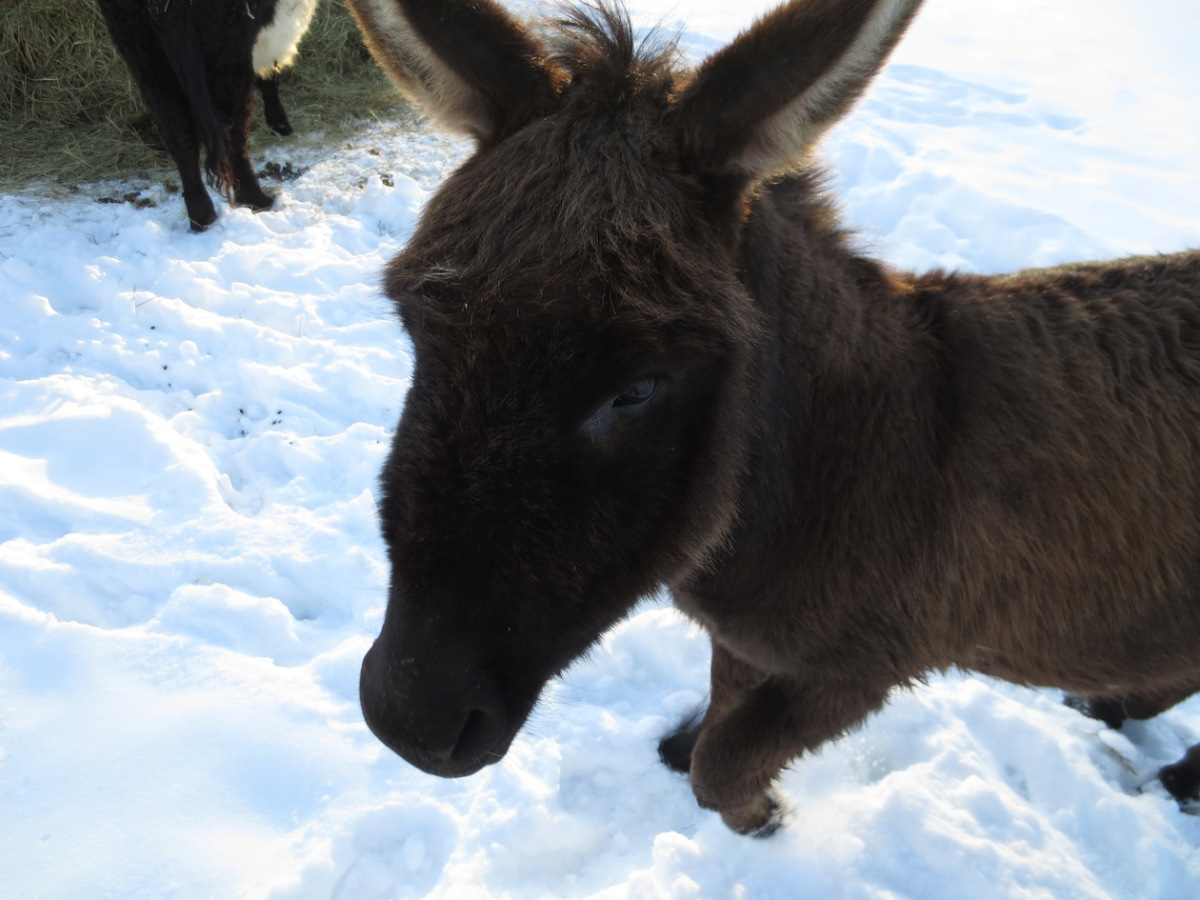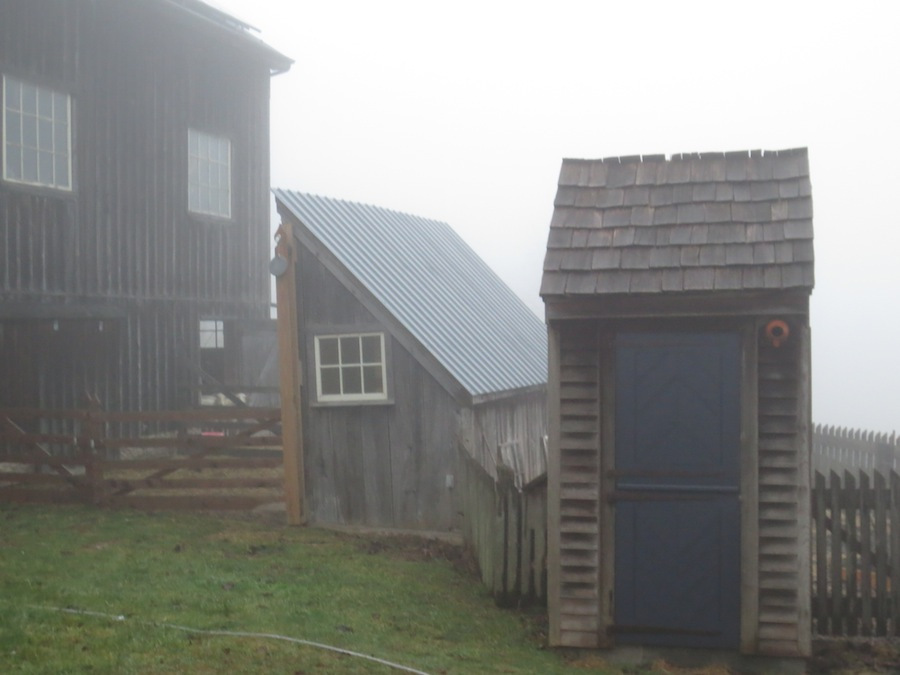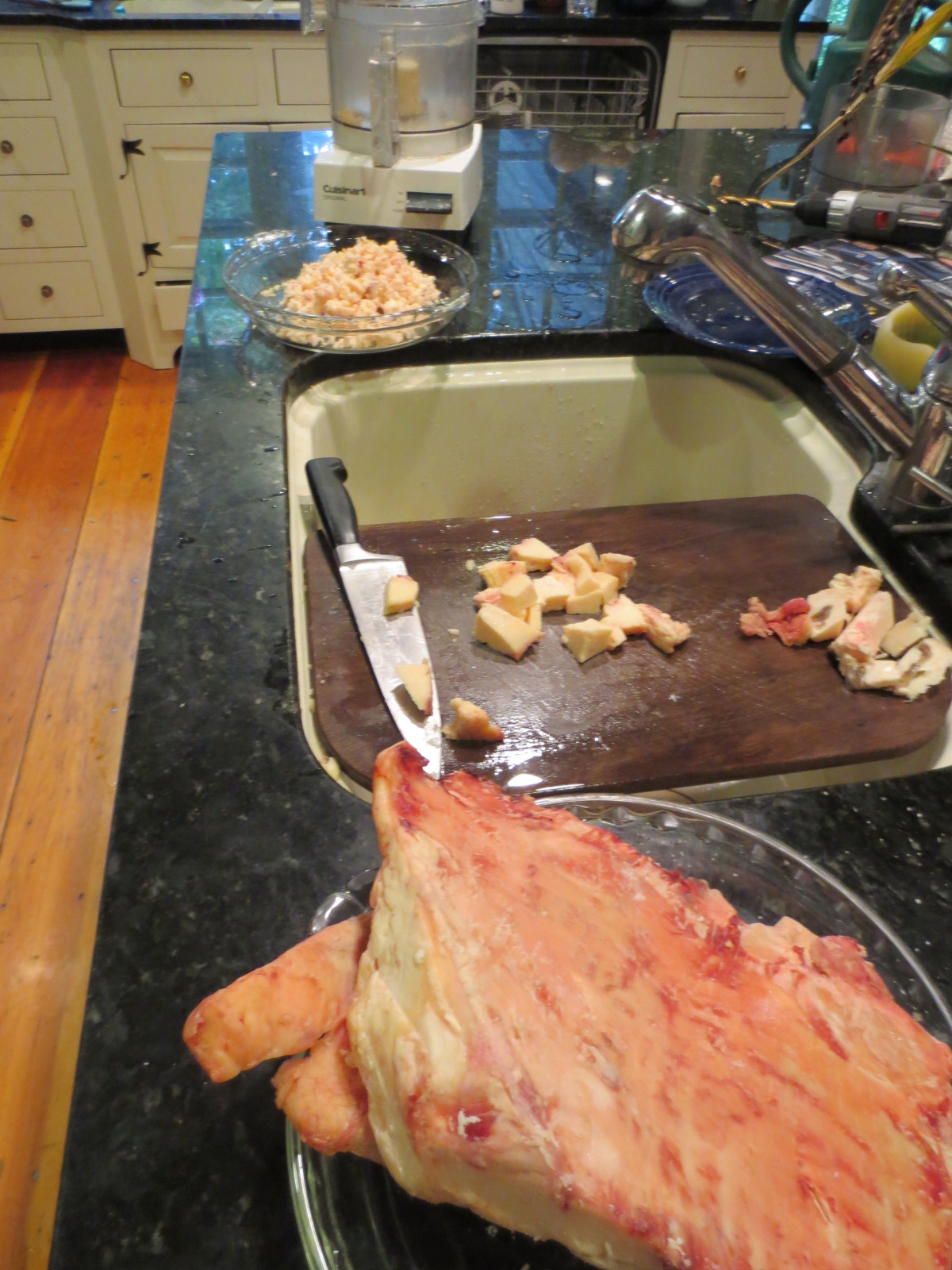After a night of dreaming of lambs I found Mauve in the ewe pen with her own spotted ram lamb before dawn. He was already cleaned off and she was nickering to all 8 pounds of him. Mauve is from the first batch of ewes we bought from Dave Hartman. In spite of losing her lamb last year, Mauve knows how to care for her lamb. Mauve is my wildest ewe.Hopefully I can calm her by handling her lamb while they spend time time in the lambing jug.
A winter break
Lilac Hill farm in late winter is all about food, water, shelter and waiting. Waiting for kids and lambs, waiting for nest making and eggs, and waiting for the first bits of green in the pastures. Already the days have lengthened and evening chores are not completed in the dark.
In spite a false alarm when I was away from the farm for 6 days, Gretel waited to kid until the week after my return.On Sunday the 24th Gretel kidded. Ernest (6#) and Cecily (8#) arrived without complications. Unfortunately Gretel's colostrum was too thick for them to nurse so we thinned the milked colustrum and bottle fed it to the Wilde kids (my daughters' name choices were inspired by Ocsar Wilde's "The Importance of Being Ernest") in front of a warming fire. The kids spent the first night in the house then were returned to the barn. All this intervention was guided by our friend, Mike, with years of goat experience and who just happened to come to dinner on Sunday. Gretel came from Mike's farm years ago.
Although we do not see the Wilde kids nurse, they do have milk in their bellies and are very active.
The Katahdin ewes have benefitted from a grain ration at the end of their pregnancies. At the end of January I noticed that the ewes, especialy the yearlings (also know as theaves or gimmers), were losing condition on a hay only diet.Because I needed to put the ram in with the ewes a month early last fall (Burgess' field companion died unexpectedly), the yearlings needed the added nutritional support as they continue to grow while pregnant. Daily, close contact, especially with delicious grain, has gentled the flock and even my shiest Katahdins tolerate closer handling. The older two ewes, Maude and Mab, are obviously getting ready to lamb. It is harder to judge the readiness of the theaves.
A break in the weather
With yesterday's warming (and sleet and rain and mist) running water returned to the barn hydrant.
To avoid sore feet or twisted legs, I will keep the pregant girls, the ewes and Gretel, in the barn. The ram and wethers will stay have access to the barnyard, but not the field with Murphy, the donkey and the Belties. With warming on the way and mud in my future, I will get a round bale out to the cows today.
The new batch of round bales are heavier and mostly Timothy. The larger bales last alot longer limiting skid steer traffic and during the coldest temperatures and the last weeks of pregnancies,when nutritional needs are high, my animals benefit.
Arctic Blast
The last week has found us in the clutches of bitter temperatures. When the temperatures dip into the single digits my barn water hydrant freezes and the frozen waterfowl troughs become too heavy to dump. Fortunately the hydrant in the boat barn is reliable and uphill from the heated field trough so draining the hose after use is easy. Until the duck and goose "ponds" melt a bit, the fowl must be content with buckets of water drawn from the cow and donkey trough. I placed the round bale of hay closer to the hill to provide northly protection from the wind.With the Katahdins and Gretel nearing the end of their pregnancies, I have changed my management practices. Gretel's earliest due date is in the middle of February. She overnights in the goat pen to avoid excess jostling and eats her portion of grain without competition. During the day she roams the barnyard for exercise, eats hay from the round bale feeder and lies in the sun. The ewes now overnight in a paddock fashioned at the bottom of the barn with two pen specific gates and two panels from the trailer pen.The ewes have two 8' troughs set up along the back wall of the barn for their portion of grain. With 16' of trough there is plenty of room for all the ewes to eat without competition. A much distressed Burgess now beds down and eats with the wedding wethers. During the coldest nights I keet the sheep and goats closed in the bottom of the barn. I set up the 4 hurdles as a moveable chute for guiding the ewes and goat away from the bins of grain and out to the paddock. In spite of the frigid temperatures I keep the sheltered door open during the day to welcome in the sun.
Becoming a shepherd is a humbling endeavor. It requires that I observe the sheep, looking for clues to conditions I often do not know exist. For example, I noticed that the yearlings' bellies were rounding, but missed that their condition score was dropping until I ran my hand along their bumpy spines. According to the advice of my books I had planned on starting to feed grain during the last week of January but, experience would have told me to start a week or two earlier. As LHF grows, so will our handling facilities. With more secure fenced fields I will be able separate the yearlings for later breeding dates, to avoid stressing their growing bodies with early first lambings. As my flock grows, staggered lambing dates will also allow me to use the pens that I have without overcrowding. My winter reading list reflects my deficiencies as a shepherd. I have been reading about nutrition and the types of hay best suited to the needs of the sheep, hoping that I will know what to look for when looking at a field ready to be cut and a round bale offered for sale. At a workshop sponsored by Fertrell's I paid particular attention to the talk about feeding small grains to rumninants. I have also been reading about lambing and watching youtube videos to refamiliarize myself with lambing-normal and troubled. Hopefuly when faced with an unexpected problem I will be able to manage and add another "thing" I notice as I tend my sheep.
January 11th, A Beautiful Barnyard Morning
The following post is not an effort to call out Murphy, not our donkey, and his fatalistic "Law" but to note my appreciation for a morning spent doing barnyard chores.
On a windless morning with choretime temperatures in the midthirties, I was hatless as I feed and watered the livestock. The long black hose, that reaches all the way to the goose trough, unrolled easily without its usual frozen stiffness. With a few days of temperatures above freezing and nights not far below, the barnyard is neither an unforgiving, frozen tract nor a sucking, muddy mess making the transfer of waste hay stems to slick or muddy spots easy. While moving forkfuls of the fluffy waste I had time to watch the animals, especially the Belties and Murphy as they investigated my work and the vacated sheep pens. Today I released the wedding sheep from the goat yard. I want them to get more exercise and get accustomed to the ram because they will be penned together when the ewes go into the lambing barn. Murphy hopped into the empty goat stall through its small, barnside door and snuffled around in search of stray grain. Each of the Belties took turns watching longingly with ony room for a black curly head through the hatch. While the cattle and donkey nosed around the barnyard the wedding sheep blended easily to the flock clustered around the hay filled round bale feeder.Hopefully without the intereference of the often present Murphy's Law, I will be able to sort the wedding sheep during evening chores and get them back in their pen for their supplement of grain.
Winter Hay Feeding
Once colder nights arrived I stopped carrying forkfuls of hay twice daily and put a round bale into the feeder.The Belties have 24 hour access to the hay. At first, the Belties and Murphy the donkey were very territorial about the hay feeder, pushing and shoving for position.
As the Katahdins trekked to the feeder Murphy would stand guard and a flick of his ear could dissuade the line of sheep from feeding.Now that there are mutiple circles of trampled hay waste dotting the field and the animals have accustomed themselves to eachother, the sheep eat their fill and head back to the barn for a rest.
Guineas
In an effort to control the tick population, Pearl Guineas were brought to Lilac Farm. They did a superb job and we did not need to treat our 4 dogs with tick repellant from May through October last year. The guineas are very wild, roosting in the trees most nights and ranging through the farmyard, fields and at the neighbor's across the road. Most of the growing season they only pecked the canning tomato plants and the corn and pumpkins, away from the main vegetable garden. They successfully raised two large clutches in the summer and after sharing two birds, eleven guineas remained. The first night they sought shelter in the barn, I captured 7 birds for the butcher. Four guineas fled into the dark.The dark purple carcasses were otherworldy. For a quick dish I sauteed the skinless breast cutlets in butter, garlic, lemon and rosemary. In spite of such little farm management we found the flavor of the tender,white meat more tasty than home grown chicken.
Now the guineas roam, usually spending the night in the barn. Next summer I will need to find a way to protect our gardens, keep the ticks and other insects under control and harvest delicious meat from those wild birds.
The wedding sheep have arrived
On Thursday we brought home four Dorset/Suffolk wethered lambs. These boys are lovely, their wooled, muscled bodies and docked tails are the image that used to come to my mind, before I started raising Katahdins. The four boys are in the goat's paddock, with its strong fences and access to a barn pen where their water will stay warm and I can feed them a daily ration of organic grain. We have installed a hay feeder on the outside wall of the barn for an additional feeding station. As of yet, the sheep have not ventured into the barn. In an effort to draw them into the pen, I left the lights on inside and their hay is in a pile just out of a lamb's neck reach.These lambs are intended for our daughter's wedding meal in May. Her wish is to serve the kind of meal shared around our own dinner table with the wedding guests. Although the wedding "table " will be considerably larger and a caterer will be preparing and serving the food, I am honored to raise these lambs for our family and friends that will celebrate with us.
I have been asked, more than once, how I can choose animals that will end up on our table. Is it uncomfortable? weird? Not really, but I am always ambivalent on butchering day. After all, for months, and in the case of our cows, years, I have been observing these animals daily, noting their gait, body shape, place in the flock or herd. Watching our animals is one of my favorite tasks as a farmsteader. I believe that if I choose to eat meat,and I didn't for 27 years, I have an obligation to eat meat that has been ethically raised or game that has been fairly hunted. Choosing how we manage our land and livestock has clarified my definition of "ethically raised". Additionally when I purchase meat or milk I try to choose so that my parameters of ethical management are met.
December flock observations
While doing the morning chores I had time to watch the Katahdins. For Lilac Hill their strong flocking behavior makes them easy to handle, moving as a group around pastures and through gates. While at rest or grazing they do seem to have preferred buddies. Queen Mab, the calmest of our first ewes on the farm, prefers the company of her daughters. She often stands aside to watch the flock. Like Mab, her daughters are calm and friendly.Mauve and Maude, also from our first set of ewes although not has calm as Mab, are barnyard friends. Maude, who adopted Marilla's orphans in the spring, has recently switched her attentions from the orphans to Mauve.
In the farm book Marilla's twins have names but since they are shy,stick together and avoid human contact, I usually think of them as "the twins". Their sire was of questionable quality so any offspring will not enter the our breeding flock and I will be watching their performance this year. Hopefully they will pass on the strengths of the Katahdin breed.Owen's 13 is a calm ewe lamb from nearby Owen's farm and does not have a particular companion.
I found lambing season gentles the ewes. I the few weeks preceding lambing I confine the ewes to the barn and barnyard. The ewes get accustomed to my comings and goings in close quarters as I do the barn chores and nighttime barn checks. After lambing, when a ewe is in the lambing jug with her new lambs, I can give individual attention to the skittish ewes and get acquainted with the lambs.
Managing a mild December
With temperatures rarely dipping into the twenties so far this December and plenty of rain this week, our sacrifice paddock and the barnyard are thick with mud. To keep the Belties from standing in too much muck while they eat, I regularly move the round bale feeder to fresh footing and spread the remaining chaff over the muddy mess. The stems that remain in the sheep and goat feeder is spread in the barnyard and in the duck and goose pens. Adding wood shavings to the sheep stall, waterfowl pens and Buckeye coop sops up some of the moisture too. Following Joel Salatin's advice, I add enough carbonaceous material to the barn area to keep it sweet smelling.
While carrying forkfuls of hay through boot sucking mud my thoughts turn to planning projects for future seasons on Lilac Hill Farm. In an effort to reclaim this sacrifice field and return it to use next winter I am researching the best combination of covercrops and vegetables to feed my livestock, capture the nutrients left on the land and reduce soil compaction. I hope to fence more of the pastures so that the sheep and cows can stay on pasture until deep snow or a frozen layer of ice demands a move into the barnyard and barn pasture. I am also starting to read about a deep bedding system for the weeks that pasturing is not possible. With hay storage moved to the top of the barn, I could probably move the ewes into the bottom of the barn on deep bedding (adding straw to my need-to-buy list). The Belites will need other accomodations too.
Undeterred by the mud that moderate temperatures, precipitation and bovine hooves churn up, mild weather chores are easier. I have another 2 1/2' of water in the cistern and so as long as I drain the hose at night, watering takes less time without hauling hose from the barn. Eggs don't crack, fingers don't numb and unfrozen buckets are easier to wash so far this December.
Ours Is A Rich Farming Community
Unlike many rural areas, ours is full of businesses that support farming endeavors. Nearby we have tractor dealers, repair garages and tire shops. Dewart Hay and Livestock Auction is in business for weekly sales and Frailey's has an equipment auction twice a year. Butcher shops that handle poultry beef, pigs , goats and sheep (more difficult to find because of Scrapie regulations) are within a 40 minute ride. More than one mobile poultry processor, offering on-premises butchering to comply with USDA poultry processing exemptions (P.L 90-492), are nearby. Welding, fencing and hauling services are easy to locate. Future Farmers of America, 4H, and Penn State Cooperative Extension offices are active in our community especial and county fairs.
Yesterday's errand run demonstrates the agricultural richness of this area. Our first stop was Norm's Farm store.Norm is from a Mennonite farming family; one of his brothers supplies some of the feed sold at the gas lit and heated store. Service at Norm's is excellent and customer appreciation days in March, with its discounts, seed company representatives seated at card tables,warm beverages and baked goods, signal the beginning of Spring. Yesterday I picked up two bales of wood shavings,read the ingredient list on a bag of F. M. Brown sheep feed and checked out the community bulletin board.
Next we picked up a load of pine boards at Ed Hoover's Sawmill. All Ed's sawmill machinery is run by compressed air powered by deisel engines. In spite of the dusty work, the mill is very tidy. Stacks of uncut logs, lumber and log stickered boules (A through-sawn log with the slices restacked in the order and orientation they originally had in the log) surround the mill buildings.
On our way to Paradise Valley Organic Farm we passed rolling hills and harvested fields, some with shocked corn and others with green winter cover crops blanketing the soil. Bucky Zeigler grows organic grains and sells certified organic feed. We loaded our bag of layer grains from the sheltered stacks at the back of the equipment shed. Bucky's expertise coupled with his local knowledge has protected me from making some greenhorn mistakes.Our last stop was at Clark's ag center for spray on polyeurethane. Clark's recently underwent a renovation, making it look and stocking it to be more like an ordinary hardware store yet within its aisles there are tools and supplies aplenty to outfit any rural property. Clark's counter staff is quick to search out odd items and many of the employees have experience on their own rural properties so they have much expertise to share.The warehouse staff loads bags of feed, rolls of fencing and scoops of gravel and mulch into waiting vehicles.Beyond our Turbotville area businesses there a other well supported farming communities within a 45 minute drive. I bought my round bale feeder at the Elimsport welding shop, visited harness shops in both Mifflinburg and Elimsport, attended my first livestock auction in Middleburg and participated in a cooperative extension pasture walk in Mainville. Eventhough long time valley residents say there are not as many businesses as in the past, thankfuly I have been able to address most of my farmstead needs locally.
Managing winter hay
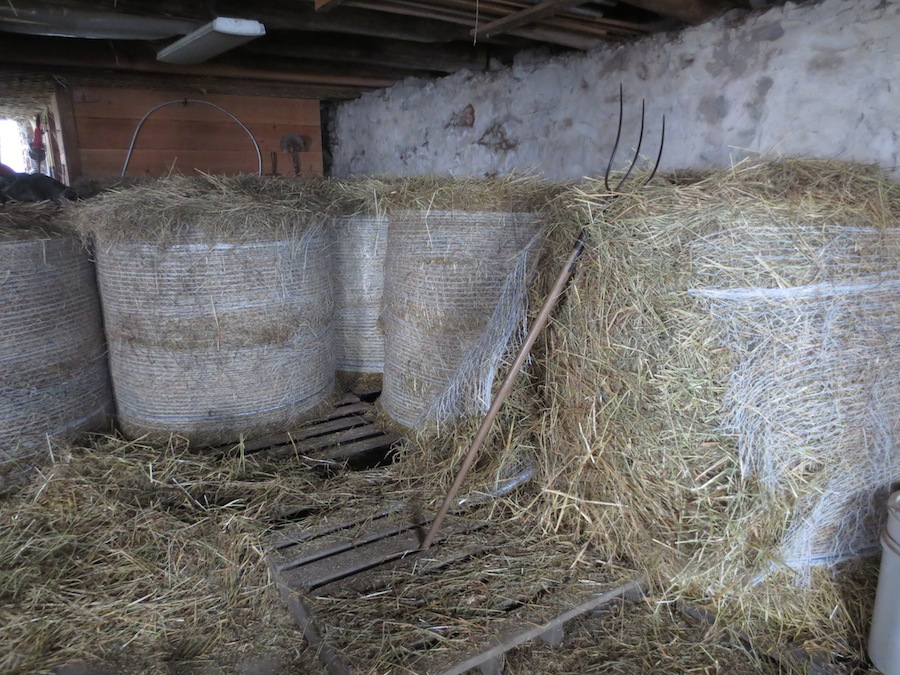 Until we have more pastures fenced for a longer grazing season, we will be feeding hay in winter. Thanks to the farmer who hays our land and nearby fields, we can purchase hay without going to the Dewart auction. Using the forks on the front of the small skidsteer I tucked 23 round bales into the bottom of our barn. Since moisture can collect at the back of the barn in wet weather, I set the round bales up on pallets along the back wall. I have been carrying forkfuls of hay to the round bale feeder for the Belties and to the Katahdin's feeder twice a day. Once the ground freezes and the wind turns cold I will fill the round bale feeder for free feeding. I have been averaging 4-5 days for each round bale so I estimate that I will need to buy hay at the beginning of February. Thankfully our farmer has plenty to buy. With the back of the barn converted to a lambing paddock, I will only have room for 4-6 round bales in February. As our flock grows we are planning keep the grazers on pastures longer and to store hay in the top of the barn in the space freed up by moving part of the woodworking shop back into the house.
Until we have more pastures fenced for a longer grazing season, we will be feeding hay in winter. Thanks to the farmer who hays our land and nearby fields, we can purchase hay without going to the Dewart auction. Using the forks on the front of the small skidsteer I tucked 23 round bales into the bottom of our barn. Since moisture can collect at the back of the barn in wet weather, I set the round bales up on pallets along the back wall. I have been carrying forkfuls of hay to the round bale feeder for the Belties and to the Katahdin's feeder twice a day. Once the ground freezes and the wind turns cold I will fill the round bale feeder for free feeding. I have been averaging 4-5 days for each round bale so I estimate that I will need to buy hay at the beginning of February. Thankfully our farmer has plenty to buy. With the back of the barn converted to a lambing paddock, I will only have room for 4-6 round bales in February. As our flock grows we are planning keep the grazers on pastures longer and to store hay in the top of the barn in the space freed up by moving part of the woodworking shop back into the house.
Using the cistern through fall
With night temperatures in the high 20's and daytime temps in the 40-50's, I can still use the cistern that catches water from the roof of the barn. Because the land slopes away from the barnyard and cistern, I disconnect the hose to let it drain nightly. This mild autumn watering set up is a real time saver over the winter routine of unrolling the hose, connecting and filling troughs, buckets and waterfowl "ponds", draining the hose by lifting it over the fence, recoiling it and carrying it back into the barn. In the winter I could probably rely on the slope of the land to drain the hose but the memory of dragging a heavy frozen hose into the house to thaw has taught me to be overly thorough in draining all the water.
Donkey proofing the gate
We rely on Murphy's equine intelligence to guard our pastured animals. He prefers the Belties to the Katahdins and goats but his bray deters any aggressor's approach. With perserverence, he discovered that he could put his head between the bars of the field gate and lift it off its hinges, alllowing him to micro-manage his little kingdom.
Four well place scews, two in each hinge, hold the hinges in place and have stymied Murphy's field management efforts.
Tools in the barn
Over time I have accumulated an assortment of tools that work in my daily chore routine. The hand truck carries bags of feed, goose pens and Rubbermaid water troughs. The forks, hay-tines up and manure-tines down, move the hay from the round bales, to the feeders then eventually scrape the manure soaked leavings from the barn floor. After time spent cleaning stalls in a horse barn, I like the look of swept floors so the broom is put to daily use and the feed shovel scoops the sweepings for the chicken coop floor. The fish net transforms into a poultry net on the farmstead and is always handy when rearranging birds. The mask keeps my lungs clear of all the dust.The nine barn cats keep our outbuildings free of rodents in spite of an outward appearance of lethargy. In the fall the felines add weight to their sleek frames and thick coats to protect against the winter weather.Once the weather chilled these lightweight Muck boots replaced my Dunlap rubber boots . When the temperature dips later this season, the heavy Mucks will be called into service.
Soapmaking Step 1: Rendering the tallow
In an effort to use as much of our butchered beef as possble, I requested that the butcher set aside non-meaty fat for rendering tallow. I asked especially for the high quality leaf fat,the fat that lines the abdominal cavity and encloses the kidneys. In order to melt evenly and efficiently, it is necessary to chop the fat into small pieces. I cubed the almost frozen fat and then pulsed it in the food processor. The slippery hilt of my knife became difficult to work with so I wore an oven mitt for better control and comfort. This year I melted the fat in a low oven in roasting pans, stirring occasionally. I found the oven method less messy than rendering on the stove and more efficient because the roasting pans held more pulverized fat.When the fatty bits firmed up and no more liquid fat was accumulating in the bottom of the roaster,I ladled the liquid through a cheesecloth lined colander into a bowl.While still warm, I transferred the rendered fat into clean canning jars. I hope that storing the tallow in jars, rather than one or two larger containers will allow me to access it conveniently. When making soap I can preliminarily weigh it and heat only as much tallow as required. A quart of tallow in the refrigerator might remind me to search out delicious recipes using beef tallow.I stored the tallow in the freezer after cooling. It was particularly fitting that I cleaned the greasy kitchen with the tallow based soap I made last year.
Burgess
Two month old Burgess is one of a triplet, raised as a twin. His torso is long and his leg is substantial. He is a rather delicate grazer, pulling dried clover flowers one by one with purposeful determination that will surely get the pasture grazed completely.
Managing the north pasture
Developing a plan for improving and utilizing a small pasture on this evolving farmstead does not fit into any manual's list of to do's.
Our north pasture borders the home yard and the orchard. It does not have a permanent fence so for any grazing I need to run polywire on pounded in posts. If I do not get the posts in the ground in the spring or after a soaking rain, the pounding is almost impossible. With easier grazing in the orchard and fenced fields, the pasture can get ahead of me as it did this year, so the hay was cut, baled and stored. Eventually I did get the pasture fenced and the cows and sheep rotated over the ground about 7 weeks after the cutting.
With only 2 cows, a heifer, a calf and and a donkey and obligations beyond the farmstead, my rotations do not look like those described by Greg Judy and the Managed Intensive Grazing crowd. Because the donkey is very protective of the cows, the bovine and ovine cannot graze together in tight quarters and with so few large creatures there is not the dramatic trampling of grasses. Buying enough posts for small paddock creation is costly since they would have to go in when the ground was soft in the spring and stay in the ground through the grazing season. Eventhough I do not move the herd daily, I have seen an improvement in the density and diversity of the pasture over the last couple years.
Next May my pasture will host a wedding so cow pies and rough growth needs to be managed.This event is not covered in the manuals so I formulated my own plan. After removing the fencing, I mowed the field in the hopes that the cut stubble will mulch and improve the soil. Depending on the earliness of the spring, the pasture may need to be mowed, perhaps to be used as green chop or left to mulch the pasture.
Ram 0257
Why a scythe?
Choosing to buy a scythe is a rather radical choice in this land of Stihl and Deere yet it may be an appropriate choice for this small property. Beyond the reach of our farmer's haymaking equipment and electric fencing lines, pasture grass grows too tall for the lawn mower and string trimmer. We have avoided purchasing a brush hog because the benefit does not balance the cost, especially since we do not have a tractor to pull a heavy mower. Until now I have donned safety glasses, ear plugs, boots and gloves to run the weed trimmer along the bottom of the fence lines. I have also gratefully borrowed a friend's heavy trimmer with harness and blade to attack the weediest lines. This hand numbing, ear ringing task is one of my least favorite jobs on the farm and I often avoid it until the electricity is being sapped from the fence enegizer. In order to keep our aged string trimmer running well I need to learn small engine repair but I do not know if that is how I want to spend my limited farm time. Purchasing and using a scythe postpones small engine repair lessons and lessens my dread of fencerow clearing.
My mornings of clearing the fencelines have been quiet with no strident motor to compete with farm sounds. Yes, the scythe has worked different muscles but the light blade does not strain my back and periodic honing of the blade gives me a chance to stretch and reposition. Removed from the mad dash to get as far along the fence perimeter as possible before the gas or string runs out, I have been able to check the hi tensile line, watching for areas that need tightening, and observe the sheep and cows in the field.
I have not attempted to clear a swath of grass on a bit of field, the fencerow clearing has been more pressing. Hopefully at some point I will mow with a rhythmic motion and the blade will whisper.
Mowing
There was never a sound beside the wood but one,
And that was my long scythe whispering to the ground.
What was it it whispered? I knew not well myself;
Perhaps it was something about the heat of the sun,
Something, perhaps, about the lack of sound—
And that was why it whispered and did not speak.
It was no dream of the gift of idle hours,
Or easy gold at the hand of fay or elf:
Anything more than the truth would have seemed too weak
To the earnest love that laid the swale in rows,
Not without feeble-pointed spikes of flowers
(Pale orchises), and scared a bright green snake.
The fact is the sweetest dream that labor knows.
My long scythe whispered and left the hay to make.
Robert Frost









